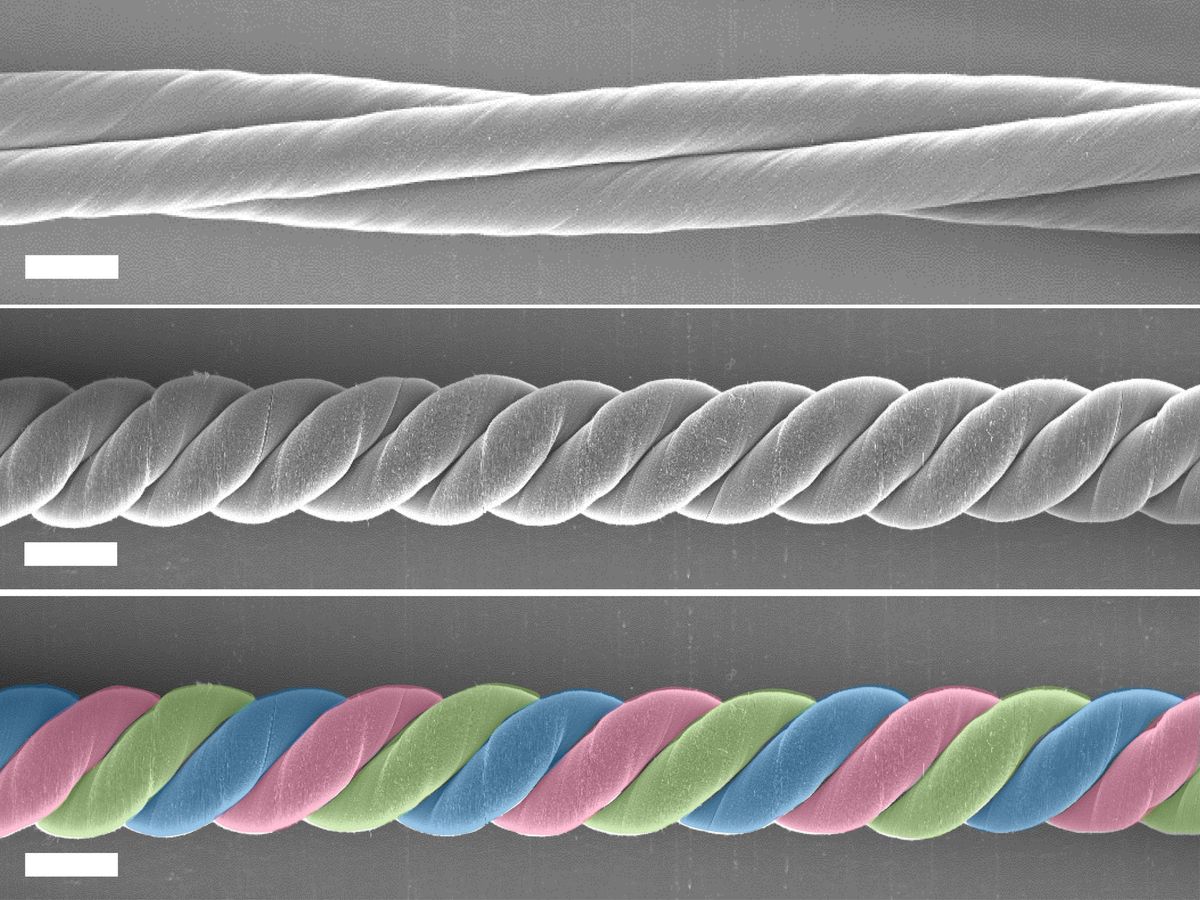Novel yarns made with carbon nanotubes can generate electricity from mechanical energy better than any other material to date, a new study finds.
The high-tech yarns, known as twistrons, can be sewn into clothes to produce electricity from human motion or deployed in the ocean to harvest energy from waves, researchers say.
Electromagnetic generators, which essentially function as electric motors run in reverse, have long been used to convert mechanical energy from wind and water to electricity. Although these perform well on large scales, they perform much less well on smaller scales. Therefore, researchers have investigated a wide variety of materials to harvest mechanical energy—for instance, using body motions to power wearable electronics.
Scientists first reported the invention of twistrons about five years ago. They created these materials by spinning carbon nanotubes into high-strength, lightweight fibers that can also incorporate electrolytes. Twisting or stretching these yarns increases their density, which in turn generates a voltage that can drive an electric current.
“Our dream in the future is to be able to use our twistrons to harvest the mechanical energy in the oceans to power cities,” says study senior author Ray Baughman, a materials scientist at the University of Texas at Dallas.
Previous research found that twistrons displayed the highest peak power of any material when it came to harvesting energy from stretching motions with frequencies between 0.1 and 30 hertz. This made them potentially interesting for a wide range of applications, such as generating energy from clothing or the ocean. However, these prior twistrons had an energy conversion efficiency of 7.6 percent at best from either twisting or stretching.
In the new study, the researchers sought to dramatically increase twistron efficiency. They have now achieved efficiencies of 17.4 percent from stretching and 22.4 percent from twisting.
“We saw a dramatic increase in efficiency,” Baughman says.
In order for them to generate electricity when compressed, previous twistrons were twisted until they coiled like an overtwisted rubber band. In the new study, the scientists instead created twistrons by intertwining three individual strands of spun carbon nanotube fibers to make a single yarn, much like how traditional wool or cotton yarns are constructed.
“Our dream in the future is to be able to use our twistrons to harvest the mechanical energy in the oceans to power cities.” —Ray Baughman, UT Dallas
Conventional yarns are typically made with strands that are twisted in one direction and then are plied together in the opposite direction to make the final yarn. This heterochiral construction provides stability against untwisting.
However, in experiments, the researchers saw the best performance from homochiral yarns, whose strands are twisted and plied in the same direction. This design resulted in “a very large increase in the yarn’s density laterally when it got stretched,” Baughman says. “This leads to increased voltage and more current.”
All in all, when it comes to harvesting energy from motions with frequencies greater than 2 hertz, the average and peak power of the new twistrons substantially exceed that of any other known material. They also show a higher power output over a wide frequency range than any other known material, researchers say.
In proof-of-concept experiments, the researchers showed a twistron array weighing only 3.2 milligrams could charge a supercapacitor, which could in turn power either five small LEDs, an electronic watch, or a digital humidity and temperature sensor with a 2.8-inch liquid-crystal display. They also sewed twistrons into a cotton fabric patch that was then wrapped around a person’s elbow, where it could produce electricity from arm bending for potential applications in sensing and energy harvesting.
In addition, the scientists explored generating electricity from ocean waves by attaching a twistron between a balloon and the bottom of an aquarium filled with saltwater. They found that it could supply an average power of about 15 to 17 watts per kilogram in scenarios that simulated either regular waves or turbulent waters.
There are materials known as dielectric elastomers that are better in terms of average power when it comes to harvesting energy from motions with very low frequencies, Baughman notes. However, these also need roughly 1,000 volts of input electricity to work, whereas the new twistrons can operate using just electric charges supplied by their electrolytes, he adds.
In the future, “We want to make the twistrons cheaper,” Baughman says. Although twistrons are currently likely too expensive for wave energy applications, they may still find use in smaller-scale applications, such as sensors and clothing, he notes.
“We’re also working on materials other than carbon nanotubes for these applications,” Baughman adds.
The scientists detailed their findings online 26 January in the journal Nature Energy. They have applied for a patent on the technology.
Charles Q. Choi is a science reporter who contributes regularly to IEEE Spectrum. He has written for Scientific American, The New York Times, Wired, and Science, among others.


